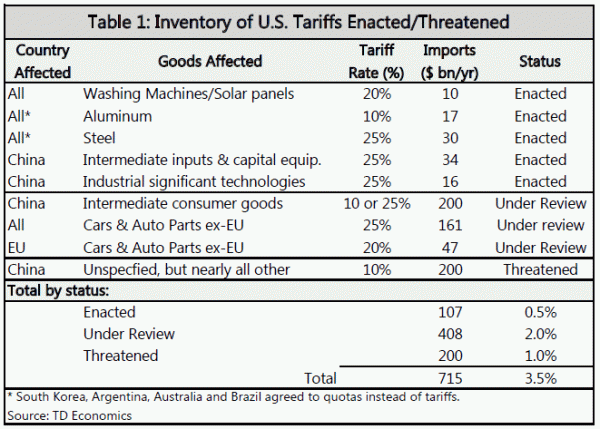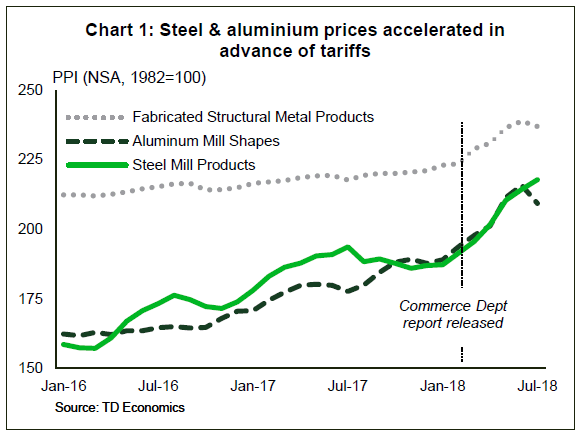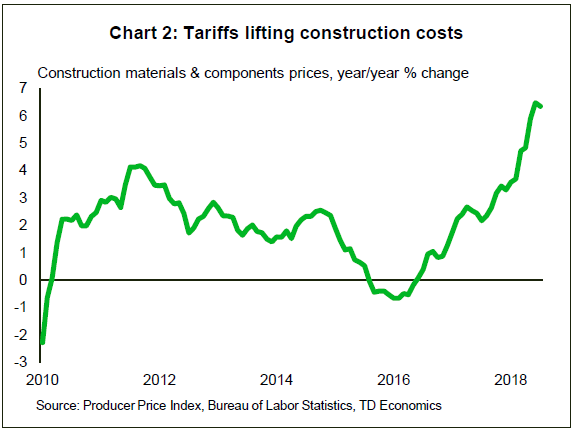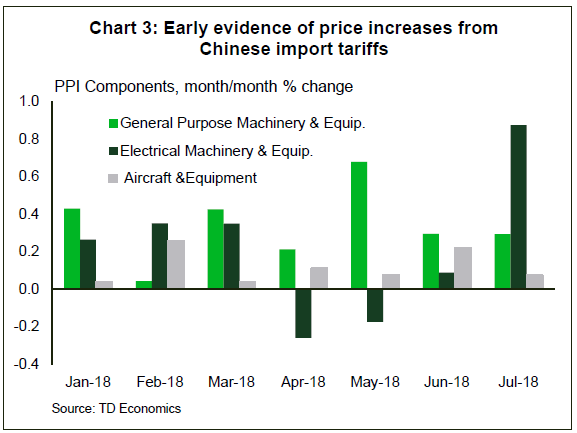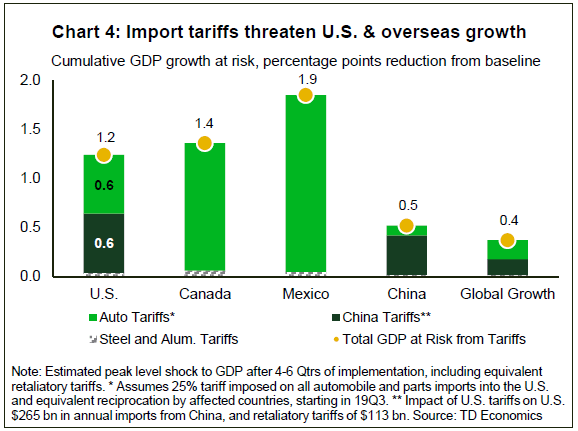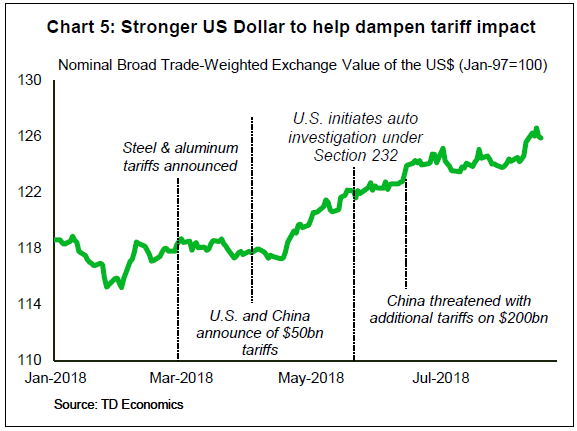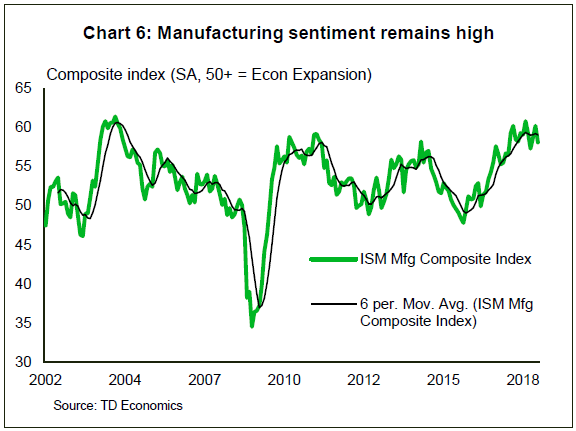Highlights
- Trade policy has been a priority of the Trump administration. Apart from NAFTA re-negotiations being back in the headlines recently, the U.S. has implemented and threatened actual tariffs on a variety of its trading partners so far in 2018. These efforts are starting to show up in prices and economic activity. But, they are not expected to derail U.S. economic momentum or add to inflation in a serious way.
- The tariffs in place so far are only the tip of the iceberg relative to those under review or threatened. If enacted, these would put a more serious damper on the U.S. and global economy. Given the size of the potential impacts, it is in the U.S.’s interest to negotiate with its trading partners and avoid a worst-case scenario.
- Tariffs also raise the risk that the Fed misinterprets the inflation momentum in the economy. It is difficult to fully disentangle one-time tariff impacts on prices.
- Even threatened tariffs can have a negative impact. Experience has shown impending tariffs can affect prices and distort business decisions. There is also early evidence that worries about tariffs are causing businesses to reassess their investment plans. That is a key downside risk to our U.S. outlook.
Negotiating better trade agreements for the U.S. was a key platform of President Trump’s election campaign. NAFTA has been going through a re-negotiation process for over a year now, and it appears a deal is getting closer (at least with Mexico). Since the tax cuts were signed into law in late 2017, the White House’s focus has shifted to trade policy, and the administration has taken actions on tariffs on numerous fronts. So far this year, the U.S. has levied tariffs on $107 billion (bn) in imports into the U.S. A variety of goods from solar panels, to steel and aluminum, to various goods from China are subject to tariffs ranging from 10-25%. America’s trading partners have increasingly responded in kind. Actual tariff action combined with those under threat or investigation amount to $715 bn. These threats and actual tariffs are having real effects on price volatility, business sentiment and trade patterns, but early dispatches suggest that the overall impact so far on the $20 trillion U.S. economy is small. However, this is not to dismiss the possibility that local impacts may be more severe due to their industry and country trade exposures.
The fact that U.S. growth is running at a healthy 3% pace in real terms on a trend basis offers a deep cushion to absorb these impacts. However, this cushion would become thinner if there is follow through on some of the larger threats at hand via both direct linkages and indirect risks. Among them, the Fed’s job of calibrating the pace of rate hikes to growing inflation pressures becomes difficult. In theory the Fed looks through the one-time impacts on inflation, but will carefully consider the potential downside risks to growth. But this may be trickier than it seems. If the Fed misjudges, it could raise rates too fast, and risk triggering the next recession. Or it might chalk inflation up to tariffs and hike rates too slowly, risking a faster pace of rate hikes later on, more in tune with slamming the brakes on economic growth later on.
Trade war has multiple fronts
It’s a full-time job keeping tabs of all the tariff threats, actions or reviews these days. The administration is fighting tariff battles on three fronts: against China, on steel and aluminum with many of its closest trading partners and allies and against auto exporting nations. Table 1 breaks it all down into actions that are in place, under review and further action that has been threatened. The U.S. has notably put tariffs on all of its top five trading partners: Canada, Mexico, China, the EU and Japan. Most countries have retaliated, but not necessarily in kind when it comes to products. Japan is the only country that hasn’t countered with tariffs on U.S. goods, although it has made threats. China has borne the brunt of the import tariffs, with about $65 bn in goods impacted so far, and tariffs up to 25% threatened on another $200 bn possible as early as next month. Knowing that retaliation impacts are small within a large U.S. economy, countries have tried to act strategically, targeting products, corporations and states that may expedite resolution.
Early signs of impacts in prices
It may be tempting to dismiss tariff threats as immaterial until they look like they will actually be implemented. But, tariffs can have an impact even before they are actually in force. For example, prices for steel and aluminum started rising once the Commerce department released its report, before tariffs were even implemented.
This is evident in price data up to July, which includes two months of the broadest steel and aluminum tariffs, and the early days of Chinese import tariffs. Since January, prices for steel and aluminum mill products are up around 15% as measured by the U.S. Producer Price index (Chart 1). Moreover, steel and aluminum tariffs are also adding to cost pressures in the construction sector. Materials and components prices had already been lifted by lumber prices, affected by softwood lumber duties levied on Canadian lumber imports in 2017 (Chart 2).
Looking at producer prices for categories that would contain many of the Chinese goods subject to tariffs, some reflected an upward thrust in July (Chart 3). Intermediate core goods inflation reached a seven-year high of 5.3%. But, some of this is likely being absorbed in profit margins because prices for producer final goods are up only 2.8% in comparison. There is also little evidence that these price increases are showing up at the consumer level yet. Core CPI inflation did reach a cycle high of 2.4% in July, but that has been driven by higher services prices rather than core goods prices.
Higher costs are likely to be passed on to consumers in part, but the transmission is typically slow (i.e. over several quarters). Many big companies have announced that they will pass along these costs to their customers. But, depending on the competitiveness of the sector, businesses may opt to cut costs, either through reduced investment or reducing staff. For now it seems that manufacturing margins are pretty healthy to absorb some of the hit. Retail and wholesale margins are a bit less favorable compared to history. Overall we expect the tariffs implemented thus far will result in a marginal 0.2%-point increase in inflation over the next four to eight quarters.
Impact of threatened tariffs much larger
Tariffs are a tax. Sometimes this simple fact can get lost in the sequence of threats and retaliation by trading partners. When the U.S. government imposes a tariff on an imported good, it is a tax on that good. The incidence of the tax is a complicated matter that depends on the structure and competitive nature of the particular industry. For example, if there is a tariff on a China-sourced input where a company has many alternate suppliers in other countries from where to source that good, the Chinese producer may have to absorb more of the impact, including a possible decline in production. If there are few substitutes than the U.S. importer would incur the higher cost of the part, and must decide whether it’s capable of either passing it along to its customers, or absorbing the cost increase. On a cumulative basis, these supply chain and price decisions by individual firms determine the ultimate growth impact on the U.S. economy. To the extent that the incidence of the import taxes falls on U.S. businesses and consumers, it hits their purchasing power and crimps spending on other things.
Thus far, the estimated growth implications of the tariffs in force are relatively small. Adding up the $50 bn in import tariffs on China to the steel and aluminum tariffs, we get roughly 0.2 percentage points (ppts) off of real GDP growth in about a year’s time, and about two tenths of a point to inflation. But when you consider the tariffs that have been threatened by the White House, the potential economic impacts become more notable (Chart 4). Auto tariffs would have material negative impact automotive exporters, and could place about 0.4 ppts of global growth at risk.
In addition, the laws of economics come into force in providing a partial, but not full, offsetting impact. Currencies react quickly to news, and often can help to facilitate the economic adjustment to tariffs. Since the beginning of the year, widening interest rate differentials and geopolitical risks have helped the green back appreciate (Chart 5). These have been compounded by trade threats and actions. The Chinese yuan in particular has depreciated approximately 8% since U.S. trade threats heated up against China in late March. These moves have acted to offset some of the impact of tariffs on the price of imported goods, and thereby mitigating the impact on importers. But, obviously not the full extent for those tariffs that can be in the double-digit range.
Another more nuanced impact of the tariffs is that they are regressive1. To the extent that higher prices are passed on to consumers, they will disproportionately be paid by lower income households who spend a larger share of their income on tradeable goods.
Apart from inflation and overall growth impacts, pending tariffs can cause distortions in business activity. Most notably, shippers ramped up U.S. soybean exports to China in the second quarter to get ahead of the tariffs, even before they knew tariffs were a certainty. This added half a percentage point to real GDP growth in the second quarter, which is likely to be reversed this quarter.
Macro impacts may be small, but localized impacts could be severe
Apart from prices, reports are becoming more commonplace of businesses taking note of the tariff environment. For example, Harley Davidson has shifted some production to Europe to avoid steel and aluminum tariffs. BMW has moved the manufacture of some vehicles to China, which are destined for that market, to avoid the retaliatory import tariffs imposed on U.S.-made SUVs. Any significant slowdown in production at BMWs South Carolina plant would cascade to many other businesses in the state, as there is a network of niche suppliers who support production at the BMW plant. The U.S. Chamber of Commerce estimates that South Carolina will be among one of the hardest hit states (8th) by the tariff measures. On this note, a TV manufacturer has already reported to be closing a South Carolina plant due to the higher cost of imported Chinese components2.
There are also anecdotal reports that steel and aluminum production has increased, or previously shuttered facilities have been reopened. But it is difficult to see a notable impact in the production or employment data as of July. The manufacturing sector had been on a cyclical upswing since mid-2016, prior to the current administration ratcheting up the rhetoric on tariffs earlier this year. Hiring in the sector accelerated since mid-2016, reflecting stronger global growth and an American product and manufacturing process that has moved up the value-chain from low cost processes and products in the past. The risk is that tariff worries dampen sentiment in the sector to an extent that actual investment takes a hit.
That is a big downside risk, and there are early signs that this may be occurring. The Fed’s July Beige Book, which covered the late May to early July period, reported that “manufacturers in all Districts expressed concern about tariffs and in many Districts reported higher prices and supply disruptions that they attributed to the new trade policies”. Overall evidence from manufacturing confidence surveys is mixed. The ISM manufacturing index has oscillated recently, but the trend looks more like a plateau at this point around a cyclical high, rather than deterioration (Chart 6). Regionally, the forward looking components of Fed manufacturing confidence surveys have held up well for the most part. The Empire Fed (New York) manufacturing index is the notable exception. It has seen the outlook component weaken in 2018.
The Atlanta Fed conducted a survey in mid-July to see how worries about tariffs are affecting investment plans3. The survey found that announced tariffs or retaliation has caused one-fifth of firms to reassess their capital expenditure plans. That share was higher at 30% for manufacturers. Of those examining their plans, two-thirds are still reassessing, while 31% have postponed or dropped previously planned expenditures and 14% have accelerated their spending plans. Overall, the Atlanta Fed finds that tariff worries have had only a small negative effect on business investment to date. Cracks are certainly showing up in business confidence, but it seems to be only at the margin. Again, this is occurring against a backdrop of very healthy investment growth expected over the coming quarters and with a number of trade threats remaining only that. If they come to pass, the downside risks will become much larger.
Potential for collateral damage
Another risk from import tariffs is a bit less obvious than investment plans. Given that tariffs are starting to show up in inflation at the producer level and are likely to filter through to some extent to consumer prices, they could be a factor raising inflation over the coming quarters. This complicates the Fed’s delicate task of calibrating its pace of rate hikes so as to keep inflation roughly around 2%. In a perfect world, the Fed will look through one-time price increases caused by tariffs. However, with Chinese tariffs are placed on a wide variety of goods along the supply chain, making it more difficult to disentangle how much inflation is due to a hot economy, and how much is the result of tariffs. That raises the risk the Fed misinterprets the inflation signal and hikes rates too quickly or not enough. The Fed will likely be very cautious in reacting to accelerating inflation in the months ahead. For now we are comfortable with our view that the Fed is set to hike rates two more times in 2018.
The Bottom line
The possibility that the current administration makes good on all of its current tariff threats is the biggest downside risk to our otherwise healthy economic outlook. However, we see this as a minimal risk at this time. The bigger likelihood is that the U.S. continues to rattle the tariff sabre, but not take full action. However, as noted above, this does carry negative knock-on effects to business investment intentions. If evidence of investment delays becomes more widespread, this can necessitate downside revisions to our forecast, particularly for business investment spending. But for now, the incoming data remains solid and the negative impact of tariffs on businesses is not widespread. The fact the U.S. economy is running at a healthy 3% pace in real terms does provide a deep cushion to absorb the negative impacts, mitigating concerns on our front.




